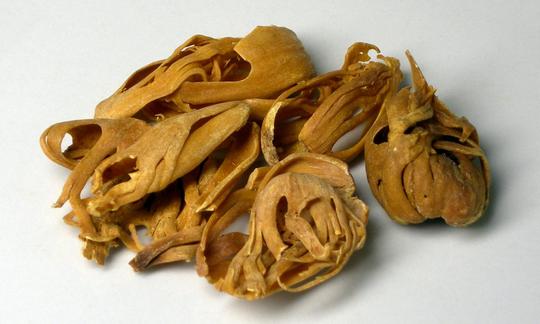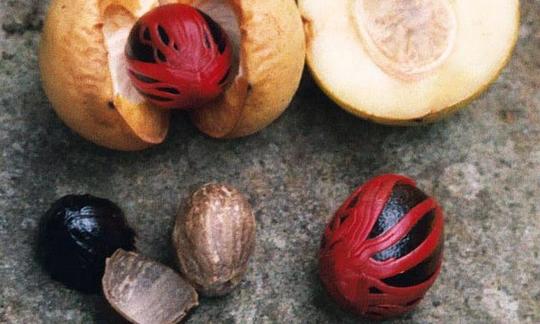Table of contents
Mace, also known as mace, is the seed coat of the nutmeg ( Myristica fragrans). It can be used whole or ground to flavor baked goods, vegetables and soups. In addition, small amounts of mace aid digestion.
Use in the kitchen:
After drying, the bright red or orange-red color of the seed coat changes to yellow-orange or yellow. Mace is only used dried, usually ground. However, the mace is also available whole, usually broken into strips. These pieces of mace are removed before serving the dishes.
What is mace powder? Mace powder is the ground or powdered seed coat of the nutmeg. The disadvantage is that you cannot grate the mace well. You have to grind it finely with a spice grinder or you can buy it in ground form.
The use of dried mace is similar to that of nutmeg: potato and cabbage dishes, spinach, sauces, soups and stews can be refined with the pleasantly warming taste of the mace flower. Even desserts such as cherry or apple cake, semolina pudding or sweet rice dishes come to life with a pinch of mace. Winter drinks such as hot chocolate, mulled wine or punch can be given a special touch with this spice.
What does mace taste like? The aroma of mace is much milder and finer than that of the more well-known nutmeg. However, the seed coat still tastes slightly aromatic and resinous and a little bitter. Some describe the taste of mace as sweet like honey or caramel, and also a little bitter like cloves.
Until the 18th century, mace was an important spice for pastries, meat dishes and sausages. In private life, mace has been somewhat forgotten as a spice, but the food industry is very fond of using it. The spice is still delicious in Bavarian white sausages and meat loaf. Like nutmeg, mace should only be used very sparingly.
Recipe for a speculaas biscuit spice with mace:
Ingredients: 35 g cinnamon (ground), 12 g cloves (ground), 12 g mace (ground), 10 g ginger (ground), 7 g cardamom (ground), 7 gpepper (black, ground).
Preparation: Mix the ground ingredients together in a bowl and store in an airtight, cool and dry place. If you use whole spices, you can finely grind the mixture in a spice mill. The amount is enough for about 2 kg of speculoos dough. This spice mixture with mace also refines Christmas desserts.
| Not only vegans or vegetarians should read this: Vegans often eat unhealthily. Avoidable nutritional errors. |
Shopping - where to buy?
You will hardly find pure mace powder or whole mace flowers in supermarket chains such as Coop, Migros, Denner, Volg, Spar, Aldi, Lidl, Rewe, Edeka, Hofer etc. In selected supermarkets, mace powder is usually available in spice mixes. Ground or whole nutmegs, on the other hand, can be bought everywhere.
You can find mace in health food stores, organic or spice shops or in online shops. The spice is often packaged in small aroma bags or sometimes available in spice tins or jars. If you prefer organic products, you can rule out contamination with pesticides, fungicides or other post-harvest or storage treatment agents.
The name "nutmeg seasoning" or "nutmeg seasoning" can be confusing for consumers. It can refer to ground nutmeg or a special spice mixture. There is also a composition of ground nutmeg, wheat bran, nutmeg oil, vegetable oil and sometimes even dry glucose syrup or the coloring paprika extract.
Storage:
Ground mace must be stored in a dry, airtight place, protected from light, then the spice will last for several months. We still recommend using whole mace over ground mace, as the quality of whole mace is much better than that of ground mace.
Found in the wild:
Originating from the Moluccas, the nutmeg tree now grows wild in almost all tropical regions. 1
Ingredients - nutritional value - calories:
Mace consists of approximately 30% fat, 50% carbohydrates and 7% protein. The energy content is 475 kcal/100g. Here too, essential oil is present in the fat content.
Like nutmeg, mace is used as a seasoning in very precise doses. The seed coat also contains phenylpropane derivatives such as myristicin, safrole, eugenol and elemicin. In higher doses, they have a carcinogenic, hallucinogenic and toxic effect on cells and genes.
Mace contains an astonishing 14 mg/100g of the trace element iron, the same amount as cardamom. Spices, dried herbs, and also many types of grain and pulses are good sources of iron. Iron is important for oxygen transport in the blood and is involved in energy metabolism. 2
Manganese is present in mace (1.5 mg/100g) in a smaller amount than in nutmeg (2.5 mg). Raw coconut meat contains just as much. Unpeeled hemp seeds have a high level of this trace element (7.6 mg), but cloves are almost unbeatable at 60 mg/100g. Manganese is important for the formation of cartilage and connective tissue, among other things. 2
Mace has 163 mg of magnesium per 100 g. This essential mineral is very important for metabolic reactions and for bone growth. Seeds, nuts, pulses and whole grains contain a lot of it: hazelnuts have the same amount of magnesium as mace. Wheat bran has a particularly high amount of this element, at 611 mg/100g. 2
100 g of mace contains 76 µg of folate. Folate is the naturally occurring precursor of folic acid. This water-soluble vitamin is very important for cell renewal. Pulses contain a lot of it, e.g. peanuts : 240 µg. 2
Mace also contains traces of calcium, riboflavin, thiamine and vitamin C. 2
Other important ingredients of mace are lignans (antioxidants) and resins as well as the carotenoid lycopene.
Health aspects - effects:
When taken internally, mace (similar to nutmeg) helps with stomach and intestinal problems. Mace is often used for mild nausea and digestive disorders. Mace is also said to have a stimulating effect.
Dangers - intolerances - side effects:
Like nutmeg, mace contains myristicin, which is poisonous to humans, although in slightly lesser amounts. With nutmeg, 4 g can cause severe poisoning in adults 3, and for small children this amount can be life-threatening. However, nutmeg does not taste good in this dose. If you take too much once, be careful not to do it a second time. 1 An overdose can cause severe headaches, nausea or dizziness. 4
Some people describe states of intoxication when taking 5 mg or more. Myristicin acts as a monoamine oxidase inhibitor (MAO inhibitor) and has a hallucinogenic effect similar to ecstasy. The long-lasting nausea and the associated liver damage prevent people from abusing it.
Ground products are often contaminated with mold because inferior, so-called BWP products (broken, wormy, punky) are used. Very toxic mycotoxins are aflatoxins such as Aspergillus parasiticus and A. flavus. They are barely visible, but infected foods glow under UV light, they fluoresce. Not only oral ingestion, but also inhalation and skin contact can cause poisoning. 5
The aflatoxin limit for nutmeg in adults is 5.0 μg/kg. For infant formula, the maximum aflatoxin content is even more strictly regulated at 0.1 μg/kg. 6
Aflatoxins have a very strong carcinogenic effect when ingested repeatedly 7, destroy germ cells and promote the formation of hematomas. 5 Animal experiments on rats showed that only 10 μg/kg body weight causes cancer (especially liver cancer). In adults, the lethal oral dose of aflatoxin B1 is 1-10 mg/kg body weight.
Use as a medicinal plant:
The essential oil is found as an ingredient in some tonics and stomach remedies. It is used externally alongside camphor and eucalyptus oil for colds and rheumatic diseases. 1
Folk medicine - naturopathy:
In the early Middle Ages, the psychoactive, hallucinogenic properties of nutmeg were used. Even today, nutmeg is said to have a stimulating and aphrodisiac effect. 3
In the past, nutmeg was abused as an abortifacient, 1.8 in England it was ground up and served with beer. 9
Occurrence - Origin:
The nutmeg tree originally comes from the Indonesian islands, the "Spice Islands". More precisely from the Moluccan islands of Banda and Amboina. The nutmeg and mace came to the West via the Arabs around 600 AD. The seed coat was mistakenly thought to be the dried flower of the nutmeg tree, hence the name. 10 There were historic battles between the Dutch, French and English for the monopoly on the trade in nutmeg. 3
Today, the nutmeg tree Myristica fragrans is cultivated in many tropical areas. Before Hurricane Ivan in 2004, the Caribbean island of Grenada was one of the main export areas for nutmeg. However, the plantations have not recovered since then. Indonesia is still the main growing country for nutmeg trees.
According to Wikipedia, the annual production of nutmeg is 10,000 to 12,000 tons. 11
Cultivation - Harvest:
The nutmeg tree needs a tropical climate, heavy rainfall and preferably rich, volcanic soil for healthy growth. 9
Nutmeg trees are dioecious, meaning that the sexes are usually found on different trees, which are difficult to tell apart in the juvenile stage. One male tree is enough to fertilize around 10 female trees. 3 There are also plants with both sexes on one tree. The leaves are leathery and usually dark green, the flowers are pale yellow with a pleasant scent.
The trees reach a height of 10-20 m. Only after the 8th year do the female trees bear fruit for about 20-30 years, which with their yellow-orange color is reminiscent of apricots or peaches. The yellow-orange, round fruit of the nutmeg tree is processed locally into jams, jellies, pickles or syrup. 12
While still hanging on the tree, the fruit flesh bursts open (opening fruit) and the bright red seed coat or aril (mace) of the nutmeg appears. The main harvest time is April to November. 9 After the harvest, the fruit flesh and seed coat are removed.
An intensive drying phase prevents the formation of mold. The unpeeled seeds and the mace, which has been freed from the kernel, are dried in the sun, over a fire or in drying houses. To obtain the nutmeg, the seed shell is broken open and the seeds contained therein are sold as the nutmeg we know. 1 The mace flowers are repeatedly pressed flat during the drying process until they reach a horn-like, firm consistency. When fully dried, the seed coat is approx. 3-4 cm long and 1 mm thick.
Myristica fragrans is very susceptible to tropical fungal diseases and pests. It is suspected that the strict isolation on the Banda Islands during the colonial period is one reason for this poor resistance. Cross-breeding with wild species was hardly permitted. 3
Risk of confusion:
Myristica fragrans can easily be confused with other species of this genus: M. argentea (horse nutmeg, Makassar nuts, Papuan nuts etc. - from Indonesia - from New Guinea), M. malabarica (Malabar nuts, Bombay mace - from India), M. speciosa (Batjang nutmeg, Pala maba, Onem, Tidore, Gosara onin - from the Moluccas), M. fatua. 9
Here is a list of some fruits that are called nutmeg but do not contain myristicin. They are often used as substitutes or adulterants: Brazilian nutmeg ( Cryptocarya moschata), Chilean nutmeg ( Laurelia sempervirens), Mace ( Acrodiclidium puchurymajor), Calabash nutmeg ( Monodora myristica), Californian nutmeg ( Torreya californica), etc.
General information:
The nutmeg tree ( Myristica fragrans) belongs to the nutmeg family (Myristicaceae). The fleshy fruit contains the seed coat, the aril - in the case of nutmeg, called mace. The mace surrounds the shell of the kernel and is initially bright red to orange-red in color. The nutmeg is located inside this shell. Botanically speaking, it is not a nut, but the seed of a fruit.
The name nutmeg comes from the Middle Latin nux muscata, which means "musk-scented nut". The English name for nutmeg is nutmeg. The seed coat, the mace (mace, mace), is called mace in English.
The drug name for mace is Myristicae arillus.
Other uses:
Essential oil is extracted from both nutmeg and mace. Essential nutmeg oil (Myristicae aetheroleum, M. fragrantis aetheroleum) is produced by steam distillation of inferior nutmegs and seed coats. 9 In addition to being used in some foods, it can also be found in ointments, toothpaste and perfumes. Essential oils should only be applied diluted because of their skin-irritating properties.
The essential oil of the green leaves of the nutmeg tree is often used to dilute or adulterate real nutmeg oil. 9
Literature - Sources:
Bibliography - 11 Sources
| 1. | Pahlow M. Das grosse Buch der Heilpflanzen. Gesund durch die Heilkräfte der Natur. Nikol: Hamburg. 2013. |
| 2. | USDA United States Department of Agriculture. |
| 3. | Brücher H. Tropische Nutzpflanzen. Ursprung, Evolution und Domestikation. Springer: Berlin, Heidelberg, New York. 1977. |
| 4. | Bown D. Encyclopedia of Herbs & their uses. DK: London. 1996. |
| 5. | Pini U. Das Bio-Food Handbuch. Ullmann: Hamburg, Potsdam. 2014. |
| 6. | Verordnung (EG) Nr. 1881/2006 der Kommission vom 19. Dezember 2006 zur Festsetzung der Höchstgehalte für bestimmte Kontaminanten in Lebensmitteln. |
| 7. | Frisvad JC, Thrane U, Samson RA et al. Important mycotoxins and the fungi which produce them. Advances in Food Mycology. 2006;571. |
| 9. | Rätsch C. Enzyklopädie der psychoaktiven Pflanzen. Botanik, Ethnopharmakologie und Anwendung. AT Verlag: Aarau. 1998. 14. Auflage. 2018. |
| 10. | Wikipedia Macis. |
| 11. | Wikipedia Muskatnussbaum. |
| 12. | Rehm S, Espig G. Die Kulturpflanzen der Tropen und Subtropen. Anbau, wirtschaftliche Bedeutung, Verwertung. Eugen Ulmer: Stuttgart. 1976. |











Comments